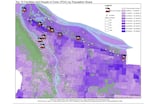Research analyzing new air pollution data from the Cleaner Air Oregon program shows people of color are more likely to live near Portland’s biggest polluters.
It's an ominous finding as data from across the country is showing both that air pollution increases health risks from COVID-19 and that African Americans and Latinos are disproportionately affected by the virus.
However, without more detailed data showing where cases of COVID-19 are located, researchers say they can’t link confirmed cases to more polluted neighborhoods.

Portland State University masters students used Cleaner Air Oregon data to map the top 10 biggest industrial polluters along with Census data on who lives nearby.
Courtesy of Portland State University
Portland State University Professor Vivek Shandas worked with a team of masters students who analyzed new air pollution data from the Cleaner Air Oregon program alongside city maps and U.S. Census information.
Shandas has already published studies showing neighborhoods that were subject to racist redlining practices starting in the 1930s now see hotter temperatures and lower air quality.
Related: Portland Air Pollution Drops Along With I-5 Traffic
New self-reported air pollution data required by the Oregon Department of Environmental Quality allowed the student research team to get a clearer picture of the communities surrounding the city's industrial air pollution.
They looked at historically redlined neighborhoods on Home Owners Loan Corporation maps and used 2010 Census data to determine who lives near the facilities that put out the most pollution.
They found 38% of people of color in the city live within 2 kilometers of the city’s top 10 polluters compared with 33% of the white population. Of all the historically redlined areas, 42% are within 1 kilometer of the city’s top 10 industrial polluters.
Pandemic implications
They weren't thinking about the implications of their findings for the coronavirus pandemic when they started the work, Shandas said. But now they're looking at how it could help identify which communities are more vulnerable to the virus.
"It turns out, this might provide a means for understanding where the communities are that have a greater sensitivity to contracting COVID-19," he said. "Just because of their already sensitized respiratory systems from being around these facilities all day."
Shandas said the coronavirus pandemic highlights disparities that he and other researchers have been pointing out for decades.
"When we see it punctuated in an event like this, we're really able to then see that air pollution in our backyard is not just a big deal because of us living next to it for a period of time, but it increases our likelihood of fatality when events like this come through," he said.
Health risks from air pollution
Scientists at Harvard recently found COVID-19 patients who live with more air pollution are more likely to die than patients who breathe cleaner air.
Dr. Lynne Messer, an associate professor and epidemiologist at Oregon Health & Science University, said because air pollution is harmful to the lungs, it makes people more vulnerable to all kinds of respiratory diseases — including COVID-19.
“Anything that’s going to undermine respiratory health, like air pollution, is going to put people at increased risk for mortality from a virus that’s going to attack people’s lungs,” she said. “If you’re living with poor air quality, you certainly would have increased risk for becoming very sick and possibly dying.”
Messer said air quality maps of Portland show poor air quality occurs in neighborhoods that are more likely to be Hispanic and African-American, and those populations are also being disproportionately affected by COVID-19.
“These are the same populations that live with greater levels of exposure to poor air quality,” she said. “Health inequities and unequal distribution of poor air quality environments around Portland are providing double jeopardy for these families.”
To make matters worse, a new study out of Italy found the virus itself can travel long distances on tiny particles of air pollution, possibly helping to spread infection.
Natalie Knowles, one of the PSU masters students who worked alongside Ariel Kane and Blair Vallie on the industrial air pollution research, said their findings highlight the legacy of housing policies that led to people of color living closer to industrial facilities.
"We know there’s a long history of racist housing policies in Portland even though a lot has been done to try to reverse some of that," she said. "I think we all came out of this like, 'Yikes. Where can Portland go from here?'"
A pandemic's clean-air lesson
The pandemic has shown the world that there are things we can do to improve air quality, Messer said.

Morning rush hour emptied of cars in Portland, Oregon's I-5 interchange during the coronavirus pandemic, March 20, 2020.
Stephani Gordon/OPB
“When I think about what would actually help these communities that are being disproportionately affected it would be shifting our thinking from how much can we pollute,” she said. “To how little would we pollute … if we wanted to provide healthier environments.”
The state's relatively new Cleaner Air Oregon program was designed to measure and reduce the health risks from industrial air pollution.
Keith Johnson, Cleaner Air Oregon program manager, said his agency looked at the demographics of the people living near air pollution and chose facilities to regulate based in part on disproportionate health impacts to vulnerable communities.
So far, the program has only brought a handful of facilities into its new permitting process. But Johnson said a lot of industrial facilities are already making changes to reduce their emissions in anticipation of the new rules.
"The impacts from the coronavirus and how those are being parsed out really put even finer point on the work we’re doing, which does look at disparate impacts," he said. "For me, it just creates an even greater sense of urgency. It turns the dial up on those impacts."
